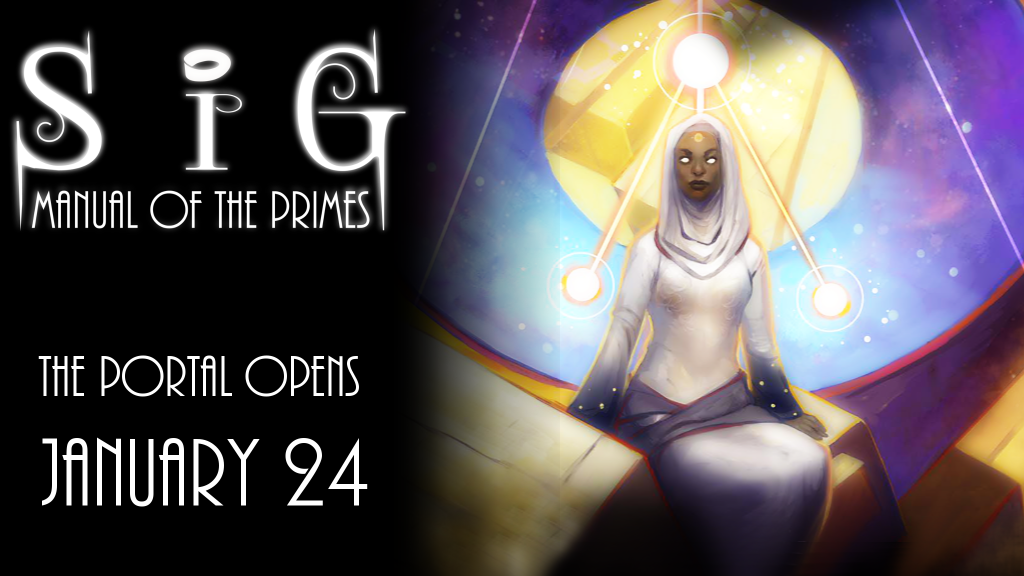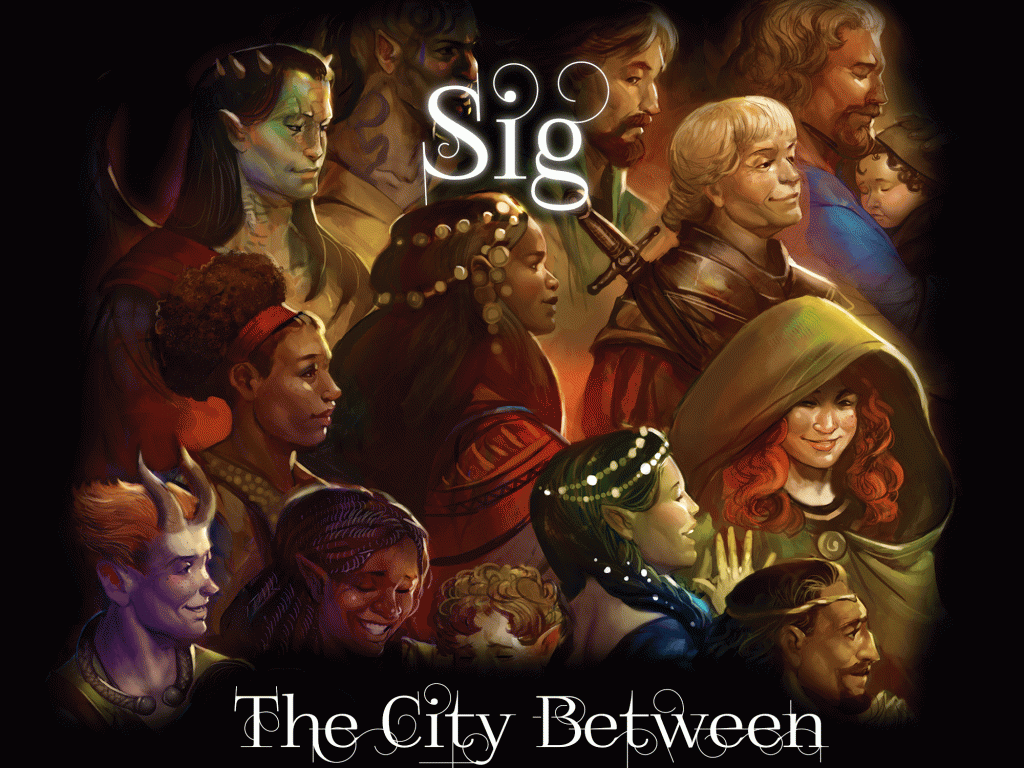Tell me about Sig. What excites you about it?
What is Sig? That questions has a lot more to it than you might think.
On the surface, Sig is an expansion for my previous game, the Spark RPG. It presents a vast new multiplanar fantasy setting to explore. It offers with mechanical refinements and new tools for storytelling. It’s even designed to encourage collaborative world building during play, as characters explore the infinite multiverse.
That’s not what the setting is really about though.
Sig is the platonic ideal of a city. Cities are actually rather strange places, when you think about them. Thousands of living, breathing souls crammed together in a small patch of land. Every city has some residents whose roots run deep, with generations upon generations residing in the same neighbourhoods. Other residents are newcomers, from near or from distant lands. Cities thrive based on the industriousness of their inhabitants, creating wonders of art, craft and ideas that spread on an international scale. Cities are hungry places, devouring obscene amounts of resources from the surrounding countryside. They are places where religions clash, where ethnic groups mix, and where languages change.
Sig is a lens through which I was able to delve deeply into what a city really means. It gave me a chance to explore how a cosmopolitan city functions and how the vast diversity of the world interacts. It’s a place to focus on those cast out by society, and those laden with privilege. It speaks of how immigration, community-building and gentrification will change the nature of neighbourhoods. Issues of class, of race, of sexuality and of gender identify are all part of the constant dialogue of the City Between.
This sounds fascinating! Can you tell me a little about the mechanical side of Sig? How does Sig tie into Spark, functionally?
So, in order to talk about the mechanics of Sig, I need to give a bit of a primer for the original core system of Spark. Spark was first, big project that I kickstarted back in 2013. It was a game about building worlds and challenging your beliefs within them. The two pillars of the game are those two key activities.
In Spark, you build worlds together. Each person names one of their favourite pieces of media; a book, game, comic, song or the like. Each person then identifies one thing about that media that really inspires them; perhaps the cosmopolitan markets of Babylon 5 or the sass of Rat Queens. As a group, you mix some of those inspirations to create facts about the world you are creating, until you have a solid framework. Those then get fleshed out by discussing the fundamental Beliefs of the setting; things like “Might makes right”, “The Emissaries are traitors” or “Love is stronger than anger”. These Beliefs inspire the various organizations that make up the world, and drive play. It’s a fun mini-game to build exciting settings that contain a little bit of everyone’s personal contributions. I even expanded that into a free product titled “A Spark in Fate Core”, which adapted that to Fate.
The rest of the game is about challenging, or confronting, your Beliefs. Like the setting itself, each character has three Beliefs. Over the course of a number of scenes, the player collaboratively establish scenes, collaborate to roleplay freely, and enter conflicts when people disagree on what should happen next. Each of these situations gives the characters the opportunities to discover evidence that refutes or supports their Beliefs, which provides a currency known as Influence. Players spend Influence to win conflicts they would otherwise lose, to avoid paying the price of victory for conflicts that they do indeed win, and to change the Beliefs of other characters.
Sig runs off the same basic foundation, but adapts it somewhat. While the Spark RPG presents four character attributes (Body, Heart, Mind & Spark), Sig reduces them to two (Spark & Smoke). Sig cares less about how conflicts are won, and more about why they are engaged in. That’s why in Sig, there is explicit discussion of Heritage (ethnicity/species), of urban Factions (guilds) and of the Powers (gods) they serve. These social ties also give the characters more ability to call upon external support through political leverage and divine rituals. The most important NPCs are also expressions of those social ties, sharing heritage, factional loyalty and religious convictions with the PCs.
Can you give examples of stories we could tell with Sig?
The stories of Sig tend to be strangely personal and emotionally gripping dramas with a vast, bizarre multiverse in a backdrop.
One of my friends played a gender-fluid ghost sex-worker who appears to people as lost loved ones and was paid in memories. They aspired to become the god of Lost Children.
Another player was a half-giantess whose conflicted relationship with her massive mother and her frail father drove her.
A third was a bestial, massive man who taught the orphans of Sig, telling himself in the dark of night that his mother hadn’t abandoned him.
Now, there may have been homocidal godlings, raging kaiju, or dragon armies involved in some of those games, but the personal stories are what stay with me.
As someone creating an expansion for an original game, what suggestions do you have for other creators, based on your experience?
Expanding on existing games is tough, both for creative and logistical reasons.
First thing to keep track of is the fact that supplements only sell a fraction of what corebooks do. Even in the good old days of the TSR boxed sets, those expansions and settings barely paid for themselves. If you want to build an expansion, you have to be absolutely sure that the product is compelling.
You need to make sure that your expansion aligns with and supports your core game, keeping the content close enough to be familiar. Paradoxically, the expansion also needs to push boundaries, offering new mechanical systems and fictional ideals to work with. It needs to broaden the scope of play, or examine one specific facet of the core book in detail.
Expansions are difficult things to create, but a successful one can breathe new life into a game.
 There is only one true city; a place of multiversal trade, cultural exchange, and mixed blood. A place where monsters come to scheme and gods come to die.
There is only one true city; a place of multiversal trade, cultural exchange, and mixed blood. A place where monsters come to scheme and gods come to die.
